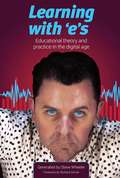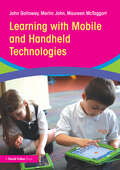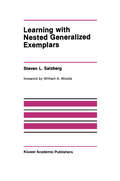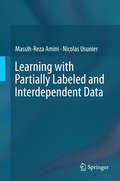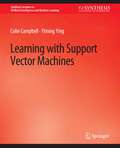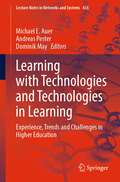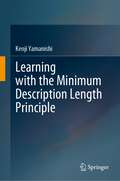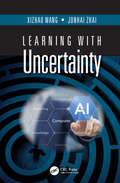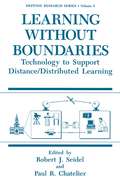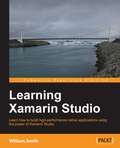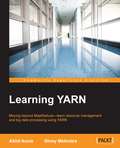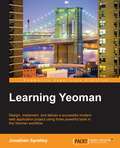- Table View
- List View
Learning VMware Workstation for Windows: Implementing and Managing VMware’s Desktop Hypervisor Solution
by Peter von OvenMaster VMware Workstation to create and run virtual machines, containers, and Kubernetes clusters simultaneously on physical devices without having to reformat or dual boot the underlying device. This book provides a practical, step-by-step guide to creating and managing virtual machines using VMware Workstation, a software solution that provides a type-2 hypervisor, or desktop hypervisor, that runs on x64 Windows and Linux-based operating systems. This book focuses on the Windows version.You’ll start with an overview of hypervisors and desktop hypervisors. You'll then look at resources, such as CPU, memory, and networking, and how they are configured in a virtual environment. In the final chapters, you’ll learn how to configure Workstation Pro to run and manage virtual machines before going on to build example virtual machines, including how to build a nested vSphere environment. Once built you’ll see how to manage these virtual machines, before finally upgrading your VMware Workstation Pro environment. In the end, you’ll learn how to build and manage different virtual machines running on different operating systems and build an ESXi lab environment with VMware Workstation. What You'll Learn Examine hypervisors and desktop hypervisorsUnderstand how to install and configure VMware WorkstationGain practical knowledge on building and managing virtual machines on different OSsSupport and troubleshoot VMware Workstation environments. Who This Book Is For Developers, IT professionals that remote, home, and BYOD
Learning Web-based Virtual Reality: Build and Deploy Web-based Virtual Reality Technology
by Srushtika Neelakantam Tanay PantCreate web-based VR applications and deploy them to GitHub pages with this short, practical tutorial crammed with hands-on examples. This book covers topics such as VR, the WebVR API, and A-Frame. In Learning Web-based Virtual Reality, you will build a number of 3D VR-based applications. In these apps, you will be able to test the VR environments, walk through the virtual world, interact with the objects, and perceive these virtual realities with the help of Google Cardboard. By the end of the book, you will have a complete understanding of what WebVR is, knowledge of what VR devices are available, and the requirements to start working on WebVR. You will also be comfortable in using A-Frame and its various components to build your own VR projects.What You Will LearnExperience WebVR, the WebVR API, and WebVR librariesMake use of various pieces of VR hardwareSee popular WebVR projectsUse A-Frame to build your own WebVR projectsWho This Book Is ForDevelopers who want to build and deploy web-based virtual reality technology. Understanding of HTML5, JavaScript, and CSS is required.
Learning Web Component Development
by Sandeep Kumar PatelThis book is the perfect reference for any web developer looking for an introduction to the new tools and techniques used to create web components.
Learning Web Development with Bootstrap and AngularJS
by Stephen RadfordWhether you know a little about Bootstrap or AngularJS, or you're a complete beginner, this book will enhance your capabilities in both frameworks and you'll build a fully functional web app. A working knowledge of HTML, CSS, and JavaScript is required to fully get to grips with Bootstrap and AngularJS.
Learning WebRTC
by Dan RisticIf you are a web developer who wants to create well designed WebRTC applications for your users, this is the book for you. Even if you are early in your web development career, this book aims to provide a complete understanding of the WebRTC API. It is assumed that you have previous exposure to web development using HTML5 and JavaScript technologies.
Learning Website Development with Django
by Ayman HouriehBeing a beginner's guide this book has a very simple and clear approach. It is a practical guide that will help you learn the features of Django and help you build a dynamic website using those features. This book is for web developers who want to see how to build a complete site with Web 2.0 features, using the power of a proven and popular development system, but do not necessarily want to learn how a complete framework functions in order to do this. Basic knowledge of Python development is required for this book, but no knowledge of Django is expected.
Learning Windows 8 Game Development
by Michael QuandtA standard practical tutorial running people through Windows 8 RT with a specific focus on game development is the approach chosen here. This type of approach will more likely appeal to an audience that is in need of a structured guide that they can emulate and learn from, unlike the usual reference text available in the market.Learning Windows 8 Game Development is for any developer looking to branch out and make some games. It's assumed that you will have an understanding of C++ and programming. If you want to program a game, this book is for you, as it will provide a great overview of Direct3D and Windows 8 game development and will kick-start your journey into 3D development.
Learning Windows Server Containers
by Srikanth MachirajuBuild, package, and deploy applications as easily manageable and shippable containers. About This Book • Discover the secret to building highly portable apps that run on any machine with Windows Server 2016 anywhere, from laptops, desktop servers, and public or private clouds, without any changes to the code • Build your company cost-effective, container-based apps that support large-scale, virtual cloud environments • The most up-to-date help on the market, offering developers expert guidance in building and shipping high-quality apps, and also helping admins create infrastructure that's simple to maintain Who This Book Is For This book is for application developers with a basic programming knowledge of C#, ASP.NET, and PowerShell. IT Administrators or DevOps engineers with basic PowerShell experience can benefit by extending their learning to use PowerShell to manage containers on Windows environments and use additional management tools. What You Will Learn • Build and deploy ASP.NET web applications as Windows Containers on Windows 10 (Desktop) and Azure using Visual Studio 2015, Docker, and PowerShell • Build and manage custom images using Windows Server Core base OS image and Docker CLI, publish images to Docker, tag images, author Docker files, and so on • Create enterprise-scale, production-grade container environments using Redis Cache containers and SQL Server containers with storage volumes, set up custom container networks, continuous integration, and deployment pipelines using VSTS, Azure, and Git • Deploy a composite container environment using Docker Compose on Windows • Learn to build applications using Microsoft's thinnest server platform - Nano Servers. Build custom Nano Server images and Nano Containers using Windows PowerShell and configure using PowerShell Core, DSC In Detail Windows Server Containers are independent, isolated, manageable and portable application environments which are light weight and shippable. Decomposing your application into smaller manageable components or MicroServices helps in building scalable and distributed application environments. Windows Server Containers have a significant impact on application developers, development operations (DevOps) and infrastructure management teams. Applications can be built, shipped and deployed in a fast-paced manner on an easily manageable and updatable environment. Learning Windows Server Containers teaches you to build simple to advanced production grade container based application using Asp.Net Core, Visual Studio, Azure, Docker and PowerShell technologies. The book teaches you to build and deploy simple web applications as Windows and Hyper-V containers on Windows 10 and Windows Server 2016 on Azure. You will learn to build on top of Windows Container Base OS Images, integrate with existing images from Docker Hub, create custom images and publish to Hub. You will also learn to work with storage containers built using Volumes and SQL Server as container, create and configure custom networks, integrate with Redis Cache containers, configure continuous integration and deployment pipelines using VSTS and Git Repository. Further you can also learn to manage resources for a container, setting up monitoring and diagnostics, deploy composite container environments using Docker Compose on Windows and manage container clusters using Docker Swarm. The last chapter of the book focuses on building applications using Microsoft's new and thinnest server platform – Nano Servers. Style and approach This hands-on tutorial helps you get started with Windows Server containers, the new trend in the container market. This example-driven guide is packed with real-world scenarios of Windows Server containers in production environments.
Learning with Digital Games: A Practical Guide to Engaging Students in Higher Education (Open and Flexible Learning Series)
by Nicola WhittonWritten for Higher Education teaching and learning professionals, Learning with Digital Games provides an accessible, straightforward introduction to the field of computer game-based learning. Up to date with current trends and the changing learning needs of today’s students, this text offers friendly guidance, and is unique in its focus on post-school education and its pragmatic view of the use of computer games with adults. Learning with Digital Games enables readers to quickly grasp practical and technological concepts, using examples that can easily be applied to their own teaching. The book assumes no prior technical knowledge but guides the reader step-by-step through the theoretical, practical and technical considerations of using digital games for learning. Activities throughout guide the reader through the process of designing a game for their own practice, and the book also offers: A toolkit of guidelines, templates and checklists. Concrete examples of different types of game-based learning using six case studies. Examples of games that show active and experiential learning Practical examples of educational game design and development. This professional guide upholds the sound reputation of the Open and Flexible Learning series, is grounded in theory and closely links examples from practice. Higher Education academics, e-learning practitioners, developers and training professionals at all technical skill levels and experience will find this text is the perfect resource for explaining "how to" integrate computer games into their teaching practice. A companion website is available and provides up-to-date technological information, additional resources and further examples.
Learning with Digital Games: A Practical Guide to Engaging Students in Higher Education (Open and Flexible Learning Series)
by Nicola WhittonWritten for Higher Education teaching and learning professionals, Learning with Digital Games provides an accessible, straightforward introduction to the field of computer game-based learning. Up to date with current trends and the changing learning needs of today’s students, this text offers friendly guidance, and is unique in its focus on post-school education and its pragmatic view of the use of computer games with adults. Learning with Digital Games enables readers to quickly grasp practical and technological concepts, using examples that can easily be applied to their own teaching. The book assumes no prior technical knowledge but guides the reader step-by-step through the theoretical, practical and technical considerations of using digital games for learning. Activities throughout guide the reader through the process of designing a game for their own practice, and the book also offers: A toolkit of guidelines, templates and checklists. Concrete examples of different types of game-based learning using six case studies. Examples of games that show active and experiential learning Practical examples of educational game design and development. This professional guide upholds the sound reputation of the Open and Flexible Learning series, is grounded in theory and closely links examples from practice. Higher Education academics, e-learning practitioners, developers and training professionals at all technical skill levels and experience will find this text is the perfect resource for explaining "how to" integrate computer games into their teaching practice. A companion website is available and provides up-to-date technological information, additional resources and further examples.
Learning With 'e's: Educational Theory And Practice In The Digital Age
by Steve WheelerIn an age where young people seem to have a natural affinity with smartphones, computer games and social media, teachers and lecturers face a big challenge or a golden opportunity. How can new technology promote learning, engage students and motivate them to sustain a lifelong career in learning? For educators everywhere, our challenge is to take devices that have the potential for great distraction and boldly appropriate them as tools that can inspire and engage. On the back of Steve s hugely popular blog, also named Learning with e s , he shows how the world of learning is changing, and how new technology and you and I can make a difference.
Learning with Fractional Orthogonal Kernel Classifiers in Support Vector Machines: Theory, Algorithms and Applications (Industrial and Applied Mathematics)
by Jamal Amani Rad Kourosh Parand Snehashish ChakravertyThis book contains select chapters on support vector algorithms from different perspectives, including mathematical background, properties of various kernel functions, and several applications. The main focus of this book is on orthogonal kernel functions, and the properties of the classical kernel functions—Chebyshev, Legendre, Gegenbauer, and Jacobi—are reviewed in some chapters. Moreover, the fractional form of these kernel functions is introduced in the same chapters, and for ease of use for these kernel functions, a tutorial on a Python package named ORSVM is presented. The book also exhibits a variety of applications for support vector algorithms, and in addition to the classification, these algorithms along with the introduced kernel functions are utilized for solving ordinary, partial, integro, and fractional differential equations.On the other hand, nowadays, the real-time and big data applications of support vector algorithms are growing. Consequently, the Compute Unified Device Architecture (CUDA) parallelizing the procedure of support vector algorithms based on orthogonal kernel functions is presented. The book sheds light on how to use support vector algorithms based on orthogonal kernel functions in different situations and gives a significant perspective to all machine learning and scientific machine learning researchers all around the world to utilize fractional orthogonal kernel functions in their pattern recognition or scientific computing problems.
Learning with Mobile and Handheld Technologies: Inside And Outside The Classroom
by John Galloway Merlin John Maureen McTaggartAs technology evolves we are ever more reliant on the use of handheld and mobile devices, yet what do we know about their impact on learning? While there is a lot of interest in mobile technology, many schools still aren’t sure how to best use it for learning and teaching. Learning with Handhelds and Mobiles explores this landscape and offers examples of how these technologies have been used for learning, how the problems that have arisen are being addressed, and offers ideas for the future. This invaluable book gives a voice to teachers and educators using mobiles and technology-enhanced learning in and out of schools, for regular school work and for innovative projects through exciting partnerships like Apps for Good. Learning with Handhelds and Mobiles shows the changes that are taking place within schools as a direct result of these emerging technologies, and contains case studies with accounts of best practice in a variety of settings including primary, secondary, and special schools, and learning beyond their boundaries. The book also explores themes of pedagogy, communication and affordances, collaborative learning, individual creativity and expression, self-directed and informal learning and outdoor education. The learning potential of handheld and mobile devices has excited teachers and educators, but until now there has been no structured, systematic overview available along with reflections on how this technology is changing educational practice. This book brings these together to provide a clearer picture of what is currently a fragmented area, and offers expert views of how we can understand these, and where it may take us next.
Learning with Mobile and Handheld Technologies
by John Galloway Merlin John Maureen McTaggartAs technology evolves we are ever more reliant on the use of handheld and mobile devices, yet what do we know about their impact on learning? While there is a lot of interest in mobile technology, many schools still aren’t sure how to best use it for learning and teaching. Learning with Handhelds and Mobiles explores this landscape and offers examples of how these technologies have been used for learning, how the problems that have arisen are being addressed, and offers ideas for the future. This invaluable book gives a voice to teachers and educators using mobiles and technology-enhanced learning in and out of schools, for regular school work and for innovative projects through exciting partnerships like Apps for Good. Learning with Handhelds and Mobiles shows the changes that are taking place within schools as a direct result of these emerging technologies, and contains case studies with accounts of best practice in a variety of settings including primary, secondary, and special schools, and learning beyond their boundaries. The book also explores themes of pedagogy, communication and affordances, collaborative learning, individual creativity and expression, self-directed and informal learning and outdoor education. The learning potential of handheld and mobile devices has excited teachers and educators, but until now there has been no structured, systematic overview available along with reflections on how this technology is changing educational practice. This book brings these together to provide a clearer picture of what is currently a fragmented area, and offers expert views of how we can understand these, and where it may take us next.
Learning with Nested Generalized Exemplars (The Springer International Series in Engineering and Computer Science #100)
by Steven L. SalzbergMachine Learning is one of the oldest and most intriguing areas of Ar tificial Intelligence. From the moment that computer visionaries first began to conceive the potential for general-purpose symbolic computa tion, the concept of a machine that could learn by itself has been an ever present goal. Today, although there have been many implemented com puter programs that can be said to learn, we are still far from achieving the lofty visions of self-organizing automata that spring to mind when we think of machine learning. We have established some base camps and scaled some of the foothills of this epic intellectual adventure, but we are still far from the lofty peaks that the imagination conjures up. Nevertheless, a solid foundation of theory and technique has begun to develop around a variety of specialized learning tasks. Such tasks in clude discovery of optimal or effective parameter settings for controlling processes, automatic acquisition or refinement of rules for controlling behavior in rule-driven systems, and automatic classification and di agnosis of items on the basis of their features. Contributions include algorithms for optimal parameter estimation, feedback and adaptation algorithms, strategies for credit/blame assignment, techniques for rule and category acquisition, theoretical results dealing with learnability of various classes by formal automata, and empirical investigations of the abilities of many different learning algorithms in a diversity of applica tion areas.
Learning with Partially Labeled and Interdependent Data
by Massih-Reza Amini Nicolas UsunierThis book develops two key machine learning principles: the semi-supervised paradigm and learning with interdependent data. It reveals new applications, primarily web related, that transgress the classical machine learning framework through learning with interdependent data. The book traces how the semi-supervised paradigm and the learning to rank paradigm emerged from new web applications, leading to a massive production of heterogeneous textual data. It explains how semi-supervised learning techniques are widely used, but only allow a limited analysis of the information content and thus do not meet the demands of many web-related tasks.Later chapters deal with the development of learning methods for ranking entities in a large collection with respect to precise information needed. In some cases, learning a ranking function can be reduced to learning a classification function over the pairs of examples. The book proves that this task can be efficiently tackled in a new framework: learning with interdependent data.Researchers and professionals in machine learning will find these new perspectives and solutions valuable. Learning with Partially Labeled and Interdependent Data is also useful for advanced-level students of computer science, particularly those focused on statistics and learning.
Learning with Support Vector Machines (Synthesis Lectures on Artificial Intelligence and Machine Learning)
by Colin Pigozzi Yiming GeneserethSupport Vectors Machines have become a well established tool within machine learning. They work well in practice and have now been used across a wide range of applications from recognizing hand-written digits, to face identification, text categorisation, bioinformatics, and database marketing. In this book we give an introductory overview of this subject. We start with a simple Support Vector Machine for performing binary classification before considering multi-class classification and learning in the presence of noise. We show that this framework can be extended to many other scenarios such as prediction with real-valued outputs, novelty detection and the handling of complex output structures such as parse trees. Finally, we give an overview of the main types of kernels which are used in practice and how to learn and make predictions from multiple types of input data. Table of Contents: Support Vector Machines for Classification / Kernel-based Models / Learning with Kernels
Learning with Technologies and Technologies in Learning: Experience, Trends and Challenges in Higher Education (Lecture Notes in Networks and Systems #456)
by Michael E. Auer Andreas Pester Dominik MayEducation has always been one of the cornerstones for societal evolution and economic growth. We are currently witnessing a significant transformation in the development of education and especially post-secondary education.The use of technology impacts the way educational content is presented and acquired in many areas. The designs of immersive educational worlds and the combination of rational and emotional educational experiences that cannot be designed in the same way in the traditional classroom will come increasingly into focus.Seen in this way the book also contributes to generalize the experience of the COVID-19 crisis and its impact to quality of learning and education.Scientifically based statements as well as excellent experiences (best practice) are necessary. This book contains scientific papers in the fields of: The future of learning Eruptive technologies in learningPedagogy of online learning Deep learning vs machine learning: opportunities and challengesReimagining and rapid transition of learningInterested readership includes policymakers, academics, educators, researchers in pedagogy and learning theory, schoolteachers, learning industry, further and continuing education lecturers, etc.
Learning with the Minimum Description Length Principle
by Kenji YamanishiThis book introduces readers to the minimum description length (MDL) principle and its applications in learning. The MDL is a fundamental principle for inductive inference, which is used in many applications including statistical modeling, pattern recognition and machine learning. At its core, the MDL is based on the premise that “the shortest code length leads to the best strategy for learning anything from data.” The MDL provides a broad and unifying view of statistical inferences such as estimation, prediction and testing and, of course, machine learning.The content covers the theoretical foundations of the MDL and broad practical areas such as detecting changes and anomalies, problems involving latent variable models, and high dimensional statistical inference, among others. The book offers an easy-to-follow guide to the MDL principle, together with other information criteria, explaining the differences between their standpoints. Written in a systematic, concise and comprehensive style, this book is suitable for researchers and graduate students of machine learning, statistics, information theory and computer science.
Learning with Uncertainty
by Xizhao Wang Junhai ZhaiLearning with uncertainty covers a broad range of scenarios in machine learning, this book mainly focuses on: (1) Decision tree learning with uncertainty, (2) Clustering under uncertainty environment, (3) Active learning based on uncertainty criterion, and (4) Ensemble learning in a framework of uncertainty. The book starts with the introduction to uncertainty including randomness, roughness, fuzziness and non-specificity and then comprehensively discusses a number of key issues in learning with uncertainty, such as uncertainty representation in learning, the influence of uncertainty on the performance of learning system, the heuristic design with uncertainty, etc. Most contents of the book are our research results in recent decades. The purpose of this book is to help the readers to understand the impact of uncertainty on learning processes. It comes with many examples to facilitate understanding. The book can be used as reference book or textbook for researcher fellows, senior undergraduates and postgraduates majored in computer science and technology, applied mathematics, automation, electrical engineering, etc.
Learning with Uncertainty
by Xizhao Wang Junhai ZhaiLearning with uncertainty covers a broad range of scenarios in machine learning, this book mainly focuses on: (1) Decision tree learning with uncertainty, (2) Clustering under uncertainty environment, (3) Active learning based on uncertainty criterion, and (4) Ensemble learning in a framework of uncertainty. The book starts with the introduction to uncertainty including randomness, roughness, fuzziness and non-specificity and then comprehensively discusses a number of key issues in learning with uncertainty, such as uncertainty representation in learning, the influence of uncertainty on the performance of learning system, the heuristic design with uncertainty, etc. Most contents of the book are our research results in recent decades. The purpose of this book is to help the readers to understand the impact of uncertainty on learning processes. It comes with many examples to facilitate understanding. The book can be used as reference book or textbook for researcher fellows, senior undergraduates and postgraduates majored in computer science and technology, applied mathematics, automation, electrical engineering, etc.
Learning without Boundaries: Technology to Support Distance/Distributed Learning (Defense Research Series #5)
by Robert J. Seidel Paul R. ChatelierThis collection of papers is the result of a workshop sponsored by NATO's Defense Research Group Panel 8 during the Fall of 1993. The workshop was held at the University of German Armed Forces at Neubiberg (Munich) Germany 29 September-l October, 1993. Robert J. Seidel Paul R. Chatelier U.S. Army Research Institute for the Executive Office of the President Behavioral and Social Sciences Office of Science and Technology Policy Washington, D.C. Washington, D.C. v PREFACE We would like to thank the authors of the papers for providing an excellent coverage of this rapidly developing technology, the session chairpersons for providing excellent structure and management for each group of papers, and each session's discussant's for their summary and personal views of their sessions papers. Our special thanks go to Dr. Rolfe Otte, the German ministry of Defense's research study group member and the person responsible for our being able to have this workshop in Munich. We are also grateful to Dr. H. Closhen of the IABG for technical and administrative assistance throughout the planning and conduct of the workshop.
Learning Xamarin Studio
by William SmithThis book is intended for .NET developers with any level of experience and who are interested in building native applications without the hassle of becoming Objective-C or Java experts. Although it will be beneficial to have some development experience, particularly in .NET, Learning Xamarin help even a novice developer get past the headaches of setting up and customizing their new development environment so they can move on to producing high-quality native applications quickly.
Learning YARN
by Akhil Arora Shrey MehrotraMoving beyond MapReduce - learn resource management and big data processing using YARN About This Book • Deep dive into YARN components, schedulers, life cycle management and security architecture • Create your own Hadoop-YARN applications and integrate big data technologies with YARN • Step-by-step guide to provision, manage, and monitor Hadoop-YARN clusters with ease Who This Book Is For This book is intended for those who want to understand what YARN is and how to efficiently use it for the resource management of large clusters. For cluster administrators, this book gives a detailed explanation of provisioning and managing YARN clusters. If you are a Java developer or an open source contributor, this book will help you to drill down the YARN architecture, write your own YARN applications and understand the application execution phases. This book will also help big data engineers explore YARN integration with real-time analytics technologies such as Spark and Storm. What You Will Learn • Explore YARN features and offerings • Manage big data clusters efficiently using the YARN framework • Create single as well as multi-node Hadoop-YARN clusters on Linux machines • Understand YARN components and their administration • Gain insights into application execution flow over a YARN cluster • Write your own distributed application and execute it over YARN cluster • Work with schedulers and queues for efficient scheduling of applications • Integrate big data projects like Spark and Storm with YARN In Detail Today enterprises generate huge volumes of data. In order to provide effective services and to make smarter and more intelligent decisions from these huge volumes of data, enterprises use big-data analytics. In recent years, Hadoop has been used for massive data storage and efficient distributed processing of data. The Yet Another Resource Negotiator (YARN) framework solves the design problems related to resource management faced by the Hadoop 1.x framework by providing a more scalable, efficient, flexible, and highly available resource management framework for distributed data processing. This book starts with an overview of the YARN features and explains how YARN provides a business solution for growing big data needs. You will learn to provision and manage single, as well as multi-node, Hadoop-YARN clusters in the easiest way. You will walk through the YARN administration, life cycle management, application execution, REST APIs, schedulers, security framework and so on. You will gain insights about the YARN components and features such as ResourceManager, NodeManager, ApplicationMaster, Container, Timeline Server, High Availability, Resource Localisation and so on. The book explains Hadoop-YARN commands and the configurations of components and explores topics such as High Availability, Resource Localization and Log aggregation. You will then be ready to develop your own ApplicationMaster and execute it over a Hadoop-YARN cluster. Towards the end of the book, you will learn about the security architecture and integration of YARN with big data technologies like Spark and Storm. This book promises conceptual as well as practical knowledge of resource management using YARN. Style and approach Starting with the basics and covering the core concepts with the practical usage, this tutorial is a complete guide to learn and explore YARN offerings.
Learning Yeoman
by Jonathan SpratleyIf you are a web developer with some experience in JavaScript and want to enter the world of modern web applications, then this book is ideal for you. Learning how to leverage the three tools (Yo, Bower, and Grunt) in the Yeoman workflow will be perfect as your next step towards building scalable, dynamic, and modern web applications for just about any platform.









